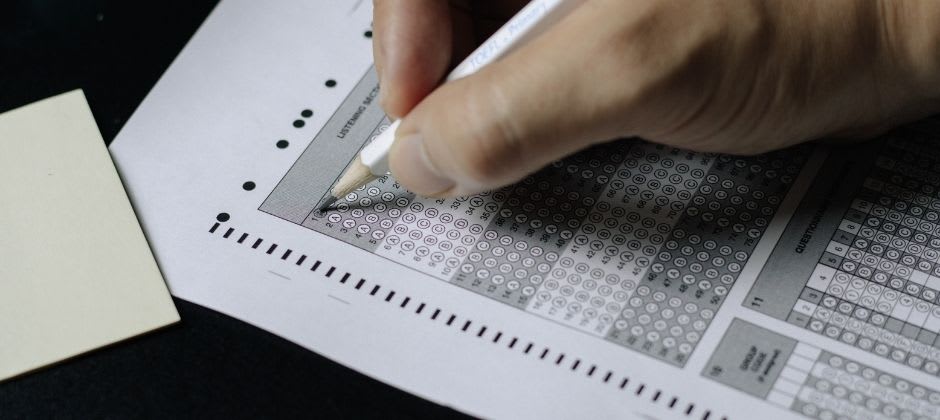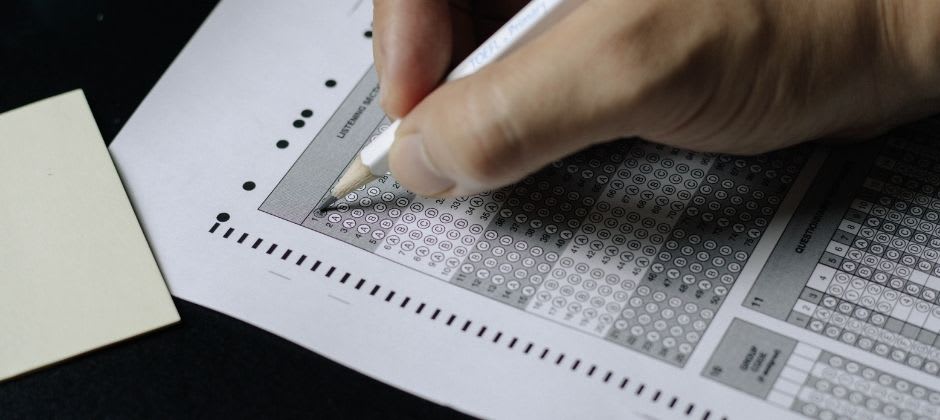The GRE Test: A Comprehensive Guide for 2024
Are you interested in pursuing Master's or MBA studies abroad? Then you should consider taking the GRE test which measures your skills in verbal and quantitative reasoning, along with analytical writing. You can take it anywhere in the world and it assists you gaining admission to your dream school!
- Master's Degree
- MBA
- GRE

If you are interested in pursuing graduate studies abroad, then you need to meet particular criteria for admission. One of them is participating in exams such as the GRE. What is the GRE used for? The GRE test for graduate school is a standardized test that will assist you in gaining admission to the university of your choice and achieve your career goals.
Whether you are pursuing a Master’s, a PhD, or an MBA degree, the GRE test for international students is a test that will add extra value to your application, evaluate your strengths and help you gain admission more easily.
The GRE test should not be perceived as a test required for admission only in the United States or Canada. It is a test widely accepted in all continents and countries like the United Kingdom or Germany as well. Are you wondering where to take the GRE? Literally everywhere with more than 1,000 official test centers!
Interested in studying a Master's program abroad?
Use our search to find and compare graduate programs around the world!
What is the GRE exam?
The GRE (Graduate Records Examination) is a standardized test for admission to graduate and business schools. It was founded in 1936 by the Carnegie Foundation for the Advancement of Teaching (CFAT) and is currently under the administration of the Educational Testing Service (ETS).
The test measures a prospective student’s qualifications in quantitative reasoning, verbal reasoning and analytical writing and is valid for five years. What makes the GRE General Test attractive to international students is the flexibility it offers. As an examinee, you get to decide which test scores to send to your schools of interest and which not. Thanks to the ScoreSelect® option, you can retake the test and pick the best scores you have gathered.
More than 1,200 business schools around the world accept GRE tests. Find the comprehensive list of the institutions and fellowship sponsors around the world that accept the GRE examination test here, by clicking on the country you are interested in studying. Additionally, here is a list with the MBA programs that accept the GRE General test.
The GRE examination supports and embraces diversity, as it is open for applicants around the world, regardless of their gender, nationality, culture and previous educational background. Most importantly, it also supports equal representation in education and assists test takers with disabilities and health-related needs. You can read more about it here.
Where to take the GRE test?
In order to be able to register for the GRE test, you will need to create an Educational Testing Service (ETS) account online and then select either the GRE General or GRE Subject Test you want to take. The GRE test is available online and at more than 1,000 test centers.
It is not only popular among prospective students in the US, but is a universal test taken by thousands of international students with a presence in more than 160 countries. The GRE exam is applicable for the majority of the countries with participants from all around the world, as seen by the General Test Volume by Country statistics of the last decade.
How frequently can you take the GRE? The test is repeated on a continuous basis for the vast majority of locations globally. However, if you are a student from China, Taiwan, Hong Kong, or Korea, the GRE test is only available up to three times per month. You can find all the test centers, seat availability, and dates here.
In case the location of your residence doesn’t allow you to visit a physical test center or the GRE General Test is not available on a computer at the center of your choice, then a GRE test at home option might be offered. The home test is not available in mainland China and Iran though.
The GRE home test is identical to the official test in the test centers with no differences in the format or duration of the exam. The only difference is that you are using your own computer or laptop and you are monitored by a human proctor through ProctorU®. Keep in mind that the home test is offered seven days a week and you can pick an available exam slot as early as 24 hours after your registration.
Average cost of the GRE test
As for the test total cost, it is set at $205 for the majority of regions around the world. Exceptions might apply based on the test location. In India, the cost is $213, in China and Australia $231, and in Nigeria $226. The cost of the exam in Turkey is slightly higher, reaching up to $255.
Fee reduction also exists if you meet specific criteria. You can check the instructions for fee reduction through this link. If you want to reschedule your test date or change a test center, then an additional fee of $50 will be applied.
The GRE test components

The GRE test is a computer-delivered test. However, paper-based examinations are also possible when an online test is not available. The test features questions that reflect on the skills you need to acquire in order to get admitted into your dream school and succeed in the contemporary business world. The GRE test length is 3 hours and 45 minutes in total, with a 10-minute break in between.
The GRE format is user-friendly and very flexible, as you can skip questions within a section, go back and change your answer anytime during the test or even choose which questions you want to answer first. The GRE test layout consists of:
Analytical Writing
The analytical writing section measures your ability to support ideas with sufficient argumentation, examine claims, sustain well-formed arguments and articulate complex ideas and concepts clearly. It is your opportunity through this first section to showcase your writing skills in English. The goal is to present as focused as possible answers based on the tasks provided. The analytical writing section consists of two parts which are timed separately: Analyze an issue task and analyze an argument task.
- The Analyze an issue task evaluates your ability to think critically about a particular topic of general interest. You need to provide an answer expressing your personal opinion about the topic. The task is accompanied by a set of instructions in order to assist you narrow down your answer, since each topic can be analyzed through various angles. Read the instructions provided to you carefully in order to avoid unnecessary mistakes.
- The Analyze an argument task measures your ability to evaluate, understand and analyze arguments. You will be provided with a written piece of work of an author who makes particular claims and provides arguments about a specific topic or event. You are expected to discuss and critically examine the coherence of the author’s claims, based once again on the instructions you will receive in the examination.
For the entire section, you will have 60 minutes to complete both tasks, with 30 minutes time for each.
Verbal Reasoning
The verbal reasoning second section includes two sub-sections with 20 questions for each section. The goal of the Verbal Reasoning task is to measure a student’s ability to select the most important points from a text by summarizing, understanding the meaning of words, sentences, and texts by distinguishing the relationship among them.
The focus is on the sensemaking of the multiple levels of meaning with the aim to take in the author’s writing intent. There are three types of questions in the Verbal Reasoning task that you can be tested in: Text completion, reading comprehension, and sentence equivalence. The Reading Comprehension appears in sets, while the remaining two sections are independent.
- To begin with, the text completion task includes a passage with one to five sentences that have some blank spaces. There are three or more answer choices for each blank space and you are asked to pick the correct answer to complete the meaning of the sentence.
- The reading comprehension task is divided into three smaller tasks: Multiple-choice questions with the option to select one answer choice, multiple-choice questions with the option to select one or more answer choices and the Select-In-Passage. During the first two tasks, you simply have to pick the correct answer or answers depending on the question.
As for the select-in-passage task, you are asked to select the sentence in the passage that meets a certain description. You can do that easily by selecting the word or sentence of your choice with your mouse and keyboard. The bigger the passage is, the more focused the instructions will be for you to narrow down the part of the text you will need to search your answer. The length of the passages could be up to five paragraphs and the topics may vary and include business, natural sciences, or humanities.
3. The sentence equivalence section consists of a single sentence and a blank space. You will be given six answer choices from which two of them are correct. Be careful to select two correct answers and not one, as partially correct answers receive zero credits.
An identified research section at the end of the test, as well as an unidentified section after the analytical writing test might appear during your GRE test. They are both not scored. The duration of the entire section is 60 minutes, with 30 minutes for each sub-section.
Quantitative Reasoning
Finally, the quantitative reasoning section evaluates a student’s ability to interpret and analyze quantitative information. Plus, it measures the student’s ability in algebra, geometry, data analysis, and problem solving with the assistance of mathematical models.
You will be provided with an on-screen calculator during the exam. This section contains four sub-sections: Quantitative comparison questions, multiple-choice questions with one or multiple answers, numeric entry questions, and data interpretation sets. Data in this section might be presented in tables, graphs, or other forms.
- The quantitative comparison questions ask you to compare two quantities, named A and B. Four statements about the quantities are provided and you need to decide which of them is correct and describe the comparison between them.
- Similar to the Reading Comprehension section, the multiple-choice section expects you to pick the correct answer or answers among the available answer choices given to you. You will have a list of five answer choices.
- The numeric entry questions ask you to give an answer as an integer or a decimal in an answer box or to enter it as a fraction in two separate boxes. In a computer-based GRE Test you can deliver the answers with your mouse and keyboard.
- The data interpretation sets questions are most of the times grouped together and are about a specific table or graph. During this task you need to analyze or interpret the data and the questions might vary and can be multiple-choice or numeric type ones.
The duration of the Quantitative Reasoning section is 70 minutes, 35 minutes for each section separately.
The GRE Subject Tests
These tests are achievement tests that measure your skills in a particular field of study. Emphasis is placed on a particular field of study and by having a GRE subject test, you will have the opportunity to stand out from the pool of applicants and gain admission to your preferred graduate school. Furthermore, it is a great way to measure your qualifications and reflect on what you need to improve.
You can participate in a subject test if you are a prospective graduate school student. You just need to have an undergraduate major and an extensive background in one of the following disciplines:
- English Literature
- Chemistry
- Biology
- Psychology
- Physics
- Mathematics
The GRE subject tests are accepted by thousands of institutions globally and can assist you in supplementing your letters of recommendation or undergraduate records when applying for graduate schools and MBA degrees. They are given at paper-delivered test centers in September, October, and April every year.
GRE Test: All you need to know about scoring
After the completion of your GRE examination, you will receive your GRE Score Report. This report includes all relevant information like your contact information, date of birth, gender, test dates, intended graduate major, your test scores with percentile ranks, and a full list of the authorized score recipients or fellowship sponsors.
Additionally, official score reports are sent to the institutions of your choice and include your personal information, intended graduate major, and your selected scores in the various sections. When referring to selected scores, the GRE gives you the ScoreSelect® option, which enables you to choose which scores will be shared with the institutions of your choice and which will not be shared. This applies both for the GRE general test and the GRE subject test.
As a result and depending on your performance, you can pick the scores that you feel most comfortable with that will increase your chances to gain admission to a graduate program. Scores are reportable for five years. You will receive your test scores online at your ETS account around two weeks after your test day.
For the GRE general test, you will receive the following scores:
- For the Verbal Reasoning, the score ranges between 130–170 points, in 1-point increments.
- Likewise, for the Quantitative Reasoning, the score ranges between 130-170 points, in 1-point increments.
- As for the Analytical Writing section, the score ranges between 0-6 points, in half point increments.
If no answers are provided in a section, this will be reported as a No Score (NS).
The Verbal Reasoning and Quantitative Reasoning sections are level adaptive. This means the computer selects the second section based on the performance of the student on the first section. All questions contribute equally to the final score. A raw score is the number of correct answers given.
When it comes to the scoring of the Analytical Writing section, the essays are scored by at least one trained rater, on a six-scale system. The essays are also scored by a computerized scoring system, the e-rater®. Both grades contribute equally to the final score.
What are good GRE scores?
If you are asking yourself “What are good GRE scores?” then you should know that a good score for you depends on the university you are applying to. Some institutions like MIT, Columbia or UPenn have higher standards than others. Check out the average GRE test score of your selected universities and do your best to achieve it!
In general, a good score is defined by an average score. The average GRE score for quantitative reasoning is set at 153.39, in verbal reasoning 150.37 and in analytical writing 3.58.
As a result, a score of 318 and above is quite good, while a score of 329 and above is considered excellent. Scoring of 292 and lower is below average for the majority of graduate schools.
The GRE Success Tools
Still wondering why to take the GRE test as an international student? The GRE test offers fairness and validity in terms of the test development, scoring processes, and administration.
It is a test that welcomes every applicant to participate and achieve the best results and the test itself represents tasks mirrored not only in a graduate school's curriculum, but also in the real-life business world. Not only that, but it also offers multiple services and resources in order to assist the test takers before or after the examination.
The GRE® Search Service
After you create your ETS account, you can add your profile in the GRE Search Service Database. Customize your profile based on your educational background, personal information, and institution preferences. Business and graduate school recruiters from around the world search through the database in order to find the top prospective students. If you match their profile, you can gain access to valuable information and establish great connections with institutions. Did you know that this service is offered for free?
Test Preparation Materials
The GRE official website provides you with a variety of sample tests or previous tests conducted in the past, in order to be fully prepared about what to expect from your GRE General or GRE Subject Test. The majority of test prep materials are offered free of charge, while some others upon payment of around $20-70.
Various Events
The GRE examination aims to provide all students with answers to their queries. You can find relevant information about the tests through the GRE webinars offered frequently, along with the information sessions and student fairs organized.
Finally, the GRE has an active presence on social media like Facebook, Instagram, Youtube, LinkedIn, Sina Weibo, and Zhihu as it aims to connect with all future applicants from all around the world. Follow the official GRE accounts on the social media networks mentioned above in order to stay updated. You can also find more detailed information in the updated GRE Information Bulletin.
Sources:

Keystone Team
Author
The Keystone Team is comprised of experienced educators and advisors dedicated to providing valuable resources and advice to students all over the world.
Read related articles

Top 5 Master's Degrees to Boost Your Business Career

These Exams Could Help Make Your Study Abroad Dream a Reality
